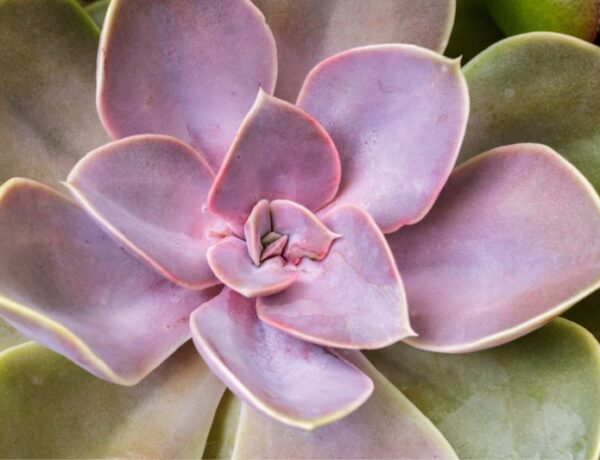Pinstripe Calathea, scientifically known as the Goeppertia ornata, is an elegant tropical plant renowned for its dark green leaves and striking light pink stripes. Not only does this plant bring a splash of color and a tropical feel to your indoor space, but it’s also relatively easy to care for when you understand its needs.
This guide will cover everything you need to know about caring for, maintaining, and propagating this Calathea variety.
Table of Contents
1. Pinstripe Calathea Quick Care Guide
[plant_care]
[article_toc]

2. Expanded Care Guide for Pinstripe Calathea
» Watering
Calatheas originate from the understory of South-American rainforests, where rainfall is frequent but soil drains quickly. Mimic that cycle indoors:
- Room-temperature, filtered water: Fluoride and chlorine in tap water can brown leaf tips. Use rain-water, aquarium water, or let tap sit out 24 h.
- Bottom-watering once a month: Place the pot in a shallow tray for 20 min. Roots absorb evenly and salt residues rise to the top for easy flushing.
- “Water weight” test: Lift the pot when it’s freshly watered, then again when the top inch is dry. You’ll learn the perfect watering rhythm by feel.
» Lighting
Bright shade is the rule, but real homes vary:
- North-window only? Supplement with a grow bulb (5 000 K, 800 lm) for six hours each evening.
- South exposure? Move the plant 4-6 ft from glass or filter with a sheer curtain—leaf tips curl if they exceed ~8 000 lux.
- Low-light rescue: Leaves lose pinstripes before they yellow. Rotate the pot weekly so each side gets even light.
» Soil
A well-draining soil mix with good aeration is best for this plant. A mix of peat, perlite, and pine bark is usually effective. Ensure that the soil is slightly acidic to neutral, with a pH range of 6.0 to 7.0.
» Temperature
The Pinstripe plant thrives in temperatures between 65°F and 75°F (18°C and 24°C). It doesn’t tolerate frost and should be kept away from drafts, air conditioners, and heaters.
» Humidity
High humidity levels of around 60-70% are ideal. You can obtain this by placing a humidifier near the plant or setting it on a tray filled with pebbles and water.
» Fertilizer
Feed your Calathea once a month during the growing season (spring and summer) with a balanced liquid fertilizer diluted to half the recommended strength. Avoid feeding during the winter months.
3. General Information & Taxonomy
| Scientific name: | Goeppertia ornata |
| Common names: | Pinstripe Calathea, Pinstripe Plant |
| Native to: | South America, primarily Colombia and Venezuela |
| Toxicity: | Non-toxic to pets and humans |
| Mature size: | Up to 2 feet in height |
| Category: | Perennial, Houseplant |
| Growth Rate: | Moderate |
| Hardiness: | Not frost-tolerant |
4. Pinstripe Calathea Maintenance and Propagation
» Repotting
Repot your plant every 1-2 years or when you notice the roots are becoming pot-bound. Choose a pot that is 1-2 inches larger in diameter than the current pot and ensure it has good drainage.
» Pruning
Pruning is generally not necessary unless you notice dead or damaged leaves. In that case, remove them by cutting close to the main stem to maintain the plant’s appearance.
» Propagation
Pinstripe Calathea can be propagated by division. During repotting, carefully separate the plant into smaller sections, ensuring each section has ample roots and at least one healthy leaf. Plant each division in its own pot filled with fresh soil.
5. Common Issues
» Leaves Turning Yellow
Over-watering or exposure to cold drafts can cause the leaves to turn yellow. Check your watering routine and ensure the plant is kept at a stable temperature.
» Leaves Turning Brown
This often happens due to low humidity or water with high mineral content. Consider using distilled or filtered water and increasing the humidity around the plant.
» Loss of Vibrant Colors
Insufficient light can cause the leaves to lose their vibrant colors. Move your plant to a brighter location but avoid direct sunlight.
6. Calathea ornata Diseases & Pests
Common pests include spider mites and aphids. Treat infestations with insecticidal soap or neem oil. Diseases are rare but can include root rot due to over-watering. Ensure proper watering habits and well-draining soil to prevent this issue.
Conclusion
Goeppertia ornata is a lovely plant that can bring a touch of the tropics to any indoor setting. With its striking leaves and relatively simple care requirements, it’s a rewarding plant to grow. By following this care guide, your Calathea will not only survive but thrive, adding beauty and elegance to your home or office.






No Comments